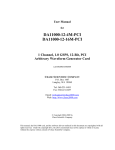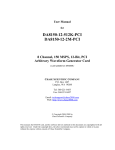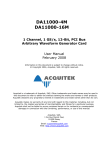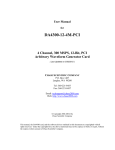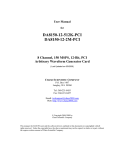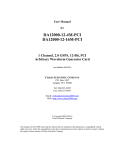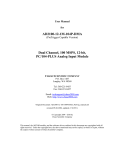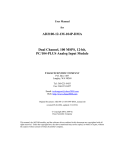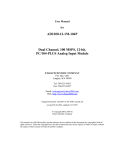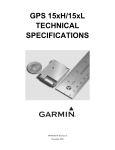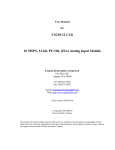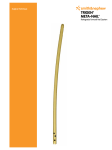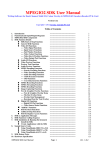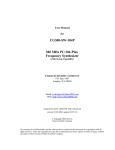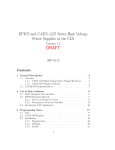Download User Manual - Chase Scientific Company
Transcript
User Manual for DA14000-12-4M-PCI DA14000-12-16M-PCI 1 Channel, 4.0 GSPS, 12-Bit, PCI Arbitrary Waveform Generator Card Last Modified 6/28/2012 CHASE SCIENTIFIC COMPANY P.O. Box 1487 Langley, WA 98260 Tel: 360-221-8455 Fax: 360-221-8457 Email: [email protected] Web: http://www.chase2000.com Copyright 2010, 2011, 2012 by Chase Scientific Company This manual, the DA14000 card, and the software drivers outlined in this document are copyrighted with all rights reserved. Under the copyright laws, the above mentioned may not be copied, in whole or in part, without the express written consent of Chase Scientific Company. DA14000 User Manual 1-Ch, 4.0 GSPS, PCI Arbitrary Waveform Generator TABLE OF CONTENTS 1 GENERAL INFORMATION.........................................................................................................................................4 1.1 INTRODUCTION ................................................................................................................................................................4 1.2 REFERENCES...................................................................................................................................................................4 1.3 DELIVERABLES................................................................................................................................................................5 1.3.1 Software...............................................................................................................................................................5 1.3.2 Hardware.............................................................................................................................................................5 1.3.3 Checklist..............................................................................................................................................................5 1.4 PRODUCT SPECIFICATION..................................................................................................................................................5 1.5 OPTION SUMMARY..........................................................................................................................................................7 1.6 TECHNICAL SUPPORT / SOFTWARE UPDATES.......................................................................................................................7 1.7 WARRANTY....................................................................................................................................................................8 2 HARDWARE DESCRIPTION.......................................................................................................................................9 2.1 INTRODUCTION................................................................................................................................................................9 2.2 BLOCK DIAGRAM ( TEMPORARY PLACEHOLDER ) ..........................................................................................................................................................................................9 2.3 BOARD DRAWING..........................................................................................................................................................10 2.4 EXTERNAL CLOCK JUMPER CONFIGURATIONS....................................................................................................................11 2.5 PCI MEMORY ALLOCATION...........................................................................................................................................11 3 THEORY OF OPERATION........................................................................................................................................12 3.1 INTRODUCTION..............................................................................................................................................................12 3.2 DOWNLOADING AND OUTPUTTING USER DATA TO THE DA14000.......................................................................................12 4 SOFTWARE DRIVERS................................................................................................................................................12 4.1 INTRODUCTION..............................................................................................................................................................12 4.2 DRIVER INSTALLATION...................................................................................................................................................13 4.2.1 Windows 98 / ME / NT4.....................................................................................................................................13 4.2.2 Windows 2000 / XP...........................................................................................................................................13 4.2.3Windows Vista / Windows 7...............................................................................................................................14 4.3 FUNCTION CALLS..........................................................................................................................................................14 4.3.1 C Header File for DLL......................................................................................................................................14 4.3.2 Function Call Descriptions / Usage..................................................................................................................16 4.3.2.1 da14000_CountCards()...............................................................................................................................................16 4.3.2.2 da14000_Open().......................................................................................................................................................... 16 4.3.2.3 da14000_Close().........................................................................................................................................................17 4.3.2.4 da14000_SetClock() [ Not Used ]...............................................................................................................................17 4.3.2.5 da14000_SetTriggerMode()........................................................................................................................................17 4.3.2.6 da14000_SetSoftTrigger() [ TBD ]..............................................................................................................................18 4.3.2.7 da14000_SetMarkers() [ See notes below ]................................................................................................................18 4.3.2.8 da14000_CreateSingleSegment()................................................................................................................................19 4.3.2.9 da14000_ CreateSegments()........................................................................................................................................19 4.3.2.10 da14000_Set_Atten() [TBD].................................................................................................................................22 4.3.2.11 da14000_UpdateSegmentCmds () [TBD]................................................................................................................23 4.4 PROGRAMMING EXAMPLES..............................................................................................................................................24 4.4.1 Using Windows 7 64-bit DLL...........................................................................................................................24 5 MISCELLANEOUS......................................................................................................................................................27 5.1 CALIBRATION................................................................................................................................................................27 5.2 MAINTANENCE..............................................................................................................................................................27 5.3 CHANGES/CORRECTIONS TO THIS MANUAL.........................................................................................................................27 © Chase Scientific Company [email protected] 2 DA14000 User Manual 1-Ch, 4.0 GSPS, PCI Arbitrary Waveform Generator ILLUSTRATIONS / TABLES FIGURE 1 – BLOCK DIAGRAM..................................................................................................................................10 FIGURE 2 – BOARD LAYOUT.....................................................................................................................................11 “da14000_manual.odt” was created on 7/11/10 and last modified on 6/28/2012 © Chase Scientific Company [email protected] 3 DA14000 User Manual 1 1-Ch, 4.0 GSPS, PCI Arbitrary Waveform Generator GENERAL INFORMATION 1.1 Introduction The DA14000 is a (1) Channel, 12-bit, 4.0 GigaSample/sec Arbitrary Waveform Generator on a single short-sized PCI card. It comes standard with following general features: - Standard Internal Fixed Clock at 4.0 GSPS (external at 4.0 GHz, 2.0 GHz, 1.0 Ghz, 500 MHz) (1) Channel Analog Output, 12-bit Vertical Resolution (2) TTL Output Marker Programmable Segment Size from 128 Data Words to full memory Programmable Number of Segments up to 32K External AC clock and External TTL/ECL trigger input The analog output consist of (1) 50 ohm SMA output, AC-Coupled. To provide maximum flexibilty and performance to the user, the outputs come unfiltered. An appropriate low pass filter is generally added in-line for a particular application and can be bought from companies like Mini-Circuits or can be ordered and/or custom made directly from Chase Scientific. The DA14000 has TTL/ECL input triggering capability that allows a segment or segments of data to be output only after a trigger is present. 1.2 References PCI Local Bus Specification, Rev. 2.1, June 1st, 1995. For more information on this document contact: PCI Special Interest Group P.O Box 14070 Portland, OR 97214 Phone: 503-619-0569 FAX: 503-644-6708 http://www.pcisig.com © Chase Scientific Company [email protected] 4 DA14000 User Manual 1.3 1.3.1 1-Ch, 4.0 GSPS, PCI Arbitrary Waveform Generator Deliverables Software The DA14000 comes with 32-bit DLL drivers for Windows 98/ME/NT4/2000/XP/Vista/7. The user can download them from our web site at “www.chase2000.com”. Email Chase Scientific for for the latest information on drivers for other operating system platforms such as Linux and 64-bit versions. Windows drivers are provided as a Dynamic Link Library (*.DLL) which is compatible with most 32-bit and 64-bit windows based development software including Microsoft C/C++, Borland C/C++, and Borland Delphi. This DLL uses the “cdecl” calling convention for maximum compatibility. It automatically provides the interface to the low level system drivers “Windrvr6.sys” for Windows 98/ME/NT4/2000/XP and “SIPLXWDF.sys” for Windows 7 32/64-bit. 1.3.2 Hardware The DA14000 hardware consists of a single short PCI compliant card. The card is shipped with this manual which includes complete hardware and software descriptions. 1.3.3 Item # 1 2 Checklist Qty 1 1 Part Number Description DA14000-12-1M-PCI DA14000 Drivers 4.0 GSPS, Arbitrary Waveform Generator, short PCI card. Optional Mini-CDR with Dynamic Link Libraries for Windows 95/98/ME/NT4/2000/XP/Vista/7. Includes examples and manual. Otherwise download from web site at: www.chase2000.com 1.4 Product Specification (all specifications are at 25 ºC unless otherwise specified) SPECIFICATIONS Parameter Analog Outputs Number of Outputs Output Coupling Vertical Resolution Amplitude Rise Time (20% to 80%) Fall Time (80% to 20%) Clock Jitter Trigger Delay Conditions Typical Values unless otherwise indicated 4.0 GS/s (1) 50 ohm SMA outputs AC coupling through 0.1uF capacitor (50 ohm source impedance) 12 bits (1 part in 4096) 0.6Vpp +/-3% typical, single ended into 50 ohms. No Filters No Filters 4.0 GS/sec 4.0 GS/sec 160 psec typical into 50 ohms 160 psec typical into 50 ohms Less than 10 psec RMS at 4 GHz TBD 4.0 GS/sec > 40 dB Typical for full scale carrier SFDR Fout < 1.3 GHz © Chase Scientific Company [email protected] 5 DA14000 User Manual Internal Clock Rate Frequency Range Resolution Stability 1-Ch, 4.0 GSPS, PCI Arbitrary Waveform Generator T=0ºC – 70ºC 4.0 GHz Fixed N/A 120 ppm Memory Waveform Size # of User Segments Segment Size Range Standard Digital Outputs (2) TTL Markers Fclk/4 resolution Digital Inputs External Clk input 50 ohm SMA input AC coupled. Can only use the following frequencies: 4.0 GHz, 2.0 Ghz, 1.0 GHz, and 500 MHz. Adjust jumpers U34 as needed. TTL Trigger input ENVIRONMENTAL Parameter Temperature Operating Non-Operating Humidity Operating Non-Operating 4 MWords / 16 MWords x 12-bits (-4M-PCI, -16M-PCI) 1 to 16K segments 128 Samples up to total memory in 128 Sample increments Used to initiate any memory segment programmed for that purpose. Typical Values unless otherwise stated 0 to 70 degrees C standard -40 to +85 degrees C extended 5 to 95% non-condensing 20% to 80% 5% to 95% Power +5V +3.3V TBD TBD +12V -12V TBD N/A DA14000 (1) Short PCI Card Size © Chase Scientific Company [email protected] 6 DA14000 User Manual 1.5 Option Summary OPTION SUMMARY Option Name TBD 1.6 1-Ch, 4.0 GSPS, PCI Arbitrary Waveform Generator Description TBD Technical Support / Software Updates For technical support: Email: Phone: Fax: Mail: [email protected] 360-221-8455 360-221-8457 Chase Scientific Company P.O. Box 1487 Langley, WA 98260 For software updates: Email: Web: [email protected] http://www.chase2000.com © Chase Scientific Company [email protected] 7 DA14000 User Manual 1.7 1-Ch, 4.0 GSPS, PCI Arbitrary Waveform Generator Warranty Chase Scientific Company (hereafter called Chase Scientific) warrants to the original purchaser that it’s DA14000, and the component parts thereof, will be free from defects in workmanship and materials for a period of ONE YEAR from the data of purchase. Chase Scientific will, without charge, repair or replace at its option, defective or component parts upon delivery to Chase Scientific’s service department within the warranty period accompanied by proof of purchase date in the form of a sales receipt. EXCLUSIONS: This warranty does not apply in the event of misuse or abuse of the product or as a result of unauthorized alterations or repairs. It is void if the serial number is altered, defaced or removed. Chase Scientific shall not be liable for any consequential damages, including without limitation damages resulting from loss of use. Some states do not allow limitation or incidental or consequential damages, so the above limitation or exclusion may not apply to you. This warranty gives you specific rights. You may also have other rights that vary from state to state. Chase Scientific warrants products sold only in the USA and Canada. In countries other than the USA, each distributor warrants the Chase Scientific products that it sells. NOTICE: Chase Scientific reserves the right to make changes and/or improvements in the product(s) described in this manual at any time without notice. © Chase Scientific Company [email protected] 8 DA14000 User Manual 2 1-Ch, 4.0 GSPS, PCI Arbitrary Waveform Generator HARDWARE DESCRIPTION 2.1 Introduction The DA14000 hardware consists of the following major connections: • (1) Normal, 4.0Gigasamples/second, 12-bit analog output (SMA) • (1) PECL/Sinewave Clock Input, 500MHz, 1.0 GHz, 2.0 GHz, 4.0 GHz ONLY (AC coupled) • (1) TTL Trigger input (SMA) • (2) TTL Outputs Markers (SMA) 2.2 Block Diagram ( Temporary Placeholder ) Figure 1 – Block Diagram ( Temporary Placeholder ) © Chase Scientific Company [email protected] 9 DA14000 User Manual 2.3 1-Ch, 4.0 GSPS, PCI Arbitrary Waveform Generator Board Drawing Clk In Trig In Aout Mark1 Mark2 Figure 2 – Board Layout © Chase Scientific Company [email protected] 10 DA14000 User Manual 2.4 1-Ch, 4.0 GSPS, PCI Arbitrary Waveform Generator External Clock Jumper Configurations U70 (ext/int clock select) Orientation for shunt is top-to-bottom. Left position uses internal clock while right position uses external clock. U34 (phase adjust) Orientation for shunt is left-to-right. Default position position performed at factory is for 4.0 GHz operation only. Other frequencies may require different selections. The purpose of this adjustment is to place the SRAM data in the center of the internal D/A clock. 2.5 PCI Memory Allocation DA14000 on-board memory is mapped automatically when a PCI 2.1 (or newer) motherboard powers up. If the DA14000 has 4 MegaSamples of memory, then the motherboard will allocate 8 Megabytes of memory. Once installed, the DA14000 software drivers will find the board or boards without the user changing any jumpers or worrying about addressing. © Chase Scientific Company [email protected] 11 DA14000 User Manual 3 1-Ch, 4.0 GSPS, PCI Arbitrary Waveform Generator THEORY OF OPERATION 3.1 Introduction Although the DA14000 is primarily comprised of a Segment Sequencer (or memory manager) and a 4:1 High Speed Multiplexor, it’s how the software interacts with the hardware that makes it work. The following sections should provide enough operational theory for better understanding when using the software drivers. 3.2 Downloading and Outputting User Data to the DA14000 The DA14000 QDR2 SRAM memory IC’s contain the user’s waveform data while the special command codes that run the Segment Sequencer are stored in separate SRAM. The Segment Sequencer reads these codes to determine where and when to jump to another segment, how many times to loop, when to wait for a trigger, and when to shut down. This is the heart of the DA14000 memory management. Downloading a Single User Waveform (single segment) into memory is performed by simply calling da14000_CreateSingleSegment(DWORD CardNum, DWORD NumPoints, DWORD NumLoops, PVOID UserArrayPtr, DWORD TrigEn). The user must be sure to pass the size of the waveform (NumPoints), the number of times to repeat the waveform (NumLoops), a pointer variable pointing to the user array containing the data (UserArrayPtr), and finally, whether the segment will be self triggered or triggered by an external signal (TrigEn). Downloading Multiple Linked Waveform Segments is performed by calling da14000_CreateSegments(DWORD CardNum, DWORD NumSegments, PVOID PtrToSegmentsList). This function call requires the user to create a structure containing all the critical information on the segments that the user wants to download. The actual structure for each segment looks like the following: typedef struct { DWORD PVOID SegmentNum; SegmentPtr; DWORD DWORD NumPoints; NumLoops; DWORD DWORD DWORD BeginPadVal; EndingPadVal; TrigEn; DWORD NextSegNum; } SegmentStruct; // // // // // // // // // // // // // Current Segment Number Pointer to current user segment ==> elements of one dimensional array must be of type DWORD Number of points in segment (must be multiple of 128) Number of times to repeat segment (applies to next segment) Reserved for future use. Reserved for future use. If > 0 then wait for trigger before going to next segment. Next segment to jump to after completion of current segment activities The user must create an array of these segments and pass the pointer (PtrToSegmentsList) to the function call. After the appropriate waveform data has been downloaded to the DA14000, da14000_SetTriggerMode() is enabled and the output begins. 4 SOFTWARE DRIVERS 4.1 Introduction © Chase Scientific Company [email protected] 12 DA14000 User Manual 1-Ch, 4.0 GSPS, PCI Arbitrary Waveform Generator Our primary objective in designing software drivers is to get the user up and running as quickly as possible. While the details on individual function calls are listed in sections 4.3.x, the programming examples in section 4.4.x will show you how to include them into your programs. Please note that function calls are the same whether you are calling them under Windows 98, ME, NT4, 2000, or XP. 4.2 Driver Installation ***IMPORTANT NOTE: Most files/directories use DA12000 instead of DA14000 because the software has been merged and works for both. It may be a little confusing at first, but bear with us until we come up with a more generic nomenclature. The purpose of the merge is to allow us to manage both products with one code base. Since the boards are 95% software identical, it makes sense to make improvements to both products at the same time. 4.2.1 Windows 98 / ME / NT4 1) Do not install DA14000 card at this time. 2) UnZip all files into directory "C:\temp\da12000\" (create directories if needed) You can move and/or copy the files later to a directory of your choice. 3) Run da12000_Register_Win98_ME_NT4.bat. This will copy the Kernel driver windrvr6.sys to "c:\<windir>\system32\drivers\" directory and will register the Kernel driver in the Windows Registry so that it starts up each time the computer is rebooted. 4) Power off computer. Insert DA14000 card. Power up computer. 5) When OS asks for Driver File point to "da12000_PCI.inf". If OS does not ask for file, then check hardware configuration and update if not listed properly under "Jungo" in Device Manager (see below). To check to see which driver is installed, do the following: => Control Panel => System => Hardware => Device Manager => Jungo DA12000_PCI WinDriver (Both this and WinDriver below should be present) If you see another driver in place of "DA12000_PCI", then right click the first device under Jungo and click properties. Update the driver by pointing to "DA12000_PCI.inf". You may have to go through a series of menus. 4.2.2 Windows 2000 / XP 1) Do not install DA14000 card at this time. © Chase Scientific Company [email protected] 13 DA14000 User Manual 1-Ch, 4.0 GSPS, PCI Arbitrary Waveform Generator 2) UnZip all files into directory "C:\temp\da12000\" (create directories if needed) You can move and/or copy the files later to a directory of your choice. 3) Run da12000_Register_Win2000_XP.bat. This will copy the Kernel driver windrvr6.sys to "c:\<windir>\system32\drivers\" directory and will register the Kernel driver in the Windows Registry so that it starts up each time the computer is rebooted. 4) Power off computer. Insert DA12000 card. Power up computer. 5) When OS asks for Driver File point to "da12000_PCI.inf". If OS does not ask for file, then check hardware configuration and update if not listed properly under "Jungo" in Device Manager (see below). To check to see which driver is installed, do the following: => Control Panel => System => Hardware => Device Manager => Jungo DA12000_PCI WinDriver (Both this and WinDriver below should be present) If you see another driver in place of "DA12000_PCI", then right click the first device under Jungo and click properties. Update the driver by pointing to "DA12000_PCI". You may have to go through a series of menus. 4.2.3 Windows Vista / Windows 7 Assumption: First time install. First install the board, then when it asks you for the driver location just point to the "SIPLXWDF.inf" file. It may take up to 20 seconds or so. Please note that you must have administrative privileges to do this. Also, to run a program on Win7 which accesses hardware you will have to assign "administrative privileges" to the executable file (right-click). Please refer all questions to: [email protected] 4.3 4.3.1 Function Calls C Header File for DLL //--------------------------------------------------------------------------#ifndef da12000_dll64_importH #define da12000_dll64_importH //--------------------------------------------------------------------------//--------------------------------------------------------------------------// USER ROUTINES © Chase Scientific Company [email protected] 14 DA14000 User Manual 1-Ch, 4.0 GSPS, PCI Arbitrary Waveform Generator //--------------------------------------------------------------------------#define IMPORT extern "C" __declspec(dllimport) // DA12000 prototypes IMPORT DWORD da12000_CountCards(void); IMPORT DWORD da12000_Open(DWORD CardNum); IMPORT DWORD da12000_Close(DWORD CardNum); IMPORT void da12000_SetClock(DWORD CardNum, DWORD Frequency); IMPORT void da12000_SetTriggerMode(DWORD CardNum, BYTE Mode, BYTE ExtPol); IMPORT void da12000_SetSoftTrigger(DWORD CardNum); IMPORT void da12000_SetOffset(DWORD CardNum, DWORD ChanNum, int Mode, int Offset); IMPORT void da12000_CreateSingleSegment(DWORD CardNum, DWORD ChanNum, DWORD NumPoints, DWORD NumLoops, PVOID UserArrayPtr, DWORD TrigEn); IMPORT void da12000_CreateSegments(DWORD CardNum, DWORD ChanNum, DWORD NumSegments, PVOID PtrToSegmentsList); IMPORT void da12000_UpdateSegmentCmds(DWORD CardNum, DWORD ChanNum, DWORD NumSegments, PVOID PtrToSegmentsList); //--------------------------------------------------------------------------// USER ROUTINES (DA14000 calls really calls to same DA12000 DLL) //--------------------------------------------------------------------------void da14000_CountCards() {return da12000_CountCards();} void da14000_Open(DWORD CardNum) {return da12000_Open(CardNum);} void da14000_Close(DWORD CardNum) {return da12000_Close(CardNum);} void da14000_SetClock(DWORD CardNum, DWORD Frequency) { da12000_SetClock(CardNum, Frequency); } void da14000_SetTriggerMode(DWORD CardNum, BYTE Mode, BYTE ExtPol) { da12000_SetTriggerMode(CardNum, Mode, ExtPol); } void da14000_SetSoftTrigger(DWORD CardNum) { da12000_SetSoftTrigger(CardNum); } void da14000_SetOffset(DWORD CardNum, DWORD ChanNum, int Mode, int Offset) { da12000_SetOffset(CardNum, ChanNum, Mode, Offset); } void da14000_CreateSingleSegment(DWORD CardNum, DWORD ChanNum, DWORD NumPoints, DWORD NumLoops, PVOID UserArrayPtr, DWORD TrigEn) { da12000_CreateSingleSegment(CardNum, ChanNum, NumPoints, NumLoops, UserArrayPtr, TrigEn); } void da14000_CreateSegments(DWORD CardNum, DWORD ChanNum, DWORD NumSegments, PVOID PtrToSegmentsList) { da12000_CreateSegments(CardNum, ChanNum, NumSegments, PtrToSegmentsList); } void da14000_UpdateSegmentCmds(DWORD CardNum, DWORD ChanNum, DWORD NumSegments, PVOID PtrToSegmentsList) { da12000_UpdateSegmentCmds(CardNum, ChanNum, NumSegments, PtrToSegmentsList); } #endif © Chase Scientific Company [email protected] 15 DA14000 User Manual 4.3.2 1-Ch, 4.0 GSPS, PCI Arbitrary Waveform Generator Function Call Descriptions / Usage 4.3.2.1 da14000_CountCards() Description Returns number of DA14000 cards present on computer. Declaration DWORD da14000_CountCards(void); Parameters none Return Value Returns with an encoded value which represents the number of DA14000. Return Values: 1-4: Number of DA14000 boards detected. 0: Indicates that no boards were found but that drivers are working properly. 13: Software drivers are not installed properly. working correctly. "13" Example DWORD Num_da14000_Boards = da14000_Open() & 0x3; 4.3.2.2 da14000_Open() Description Loads the DA14000 software drivers and sets the DA14000 board to its default state. Declaration DWORD da14000_Open(DWORD CardNum); Parameters CardNum: 1 <= CardNum <= 4 Return Value Returns with error code. A "0" means everything is fine. See below for details for other values. Return Values: 0: Opened Windriver Successfully and DA14000 Card Found Successfully 1: Opened Windriver Successfully, but NO DA14000 CARDS FOUND 2: Opened Windriver Successfully, Card found, but unable to open. 3: Opened Windriver Successfully, Board already open. 6: Card number exceeds number of cards. 13: FAILED TO OPEN Windriver Kernel Driver Example DWORD OpenErrorCode = da14000_Open(1); © Chase Scientific Company // Opens Board Number 1 and stores value. [email protected] 16 DA14000 User Manual 1-Ch, 4.0 GSPS, PCI Arbitrary Waveform Generator 4.3.2.3 da14000_Close() Description Closes DA14000 drivers. Should be called after finishing using the driver. However, if no other software uses the “windrv.xxx” (usual situation), then there is no need to close it until user is ready to completely exit from using their main software program which calls “windrv.xxx”. If the user is loading the “windrv.xxx” dynamically (during run time), then they should close before unloading the driver. Declaration DWORD da14000_Close(DWORD CardNum); Parameters CardNum: 1 <= CardNum <= 4 Return Value Returns with error code. A "0" means everything is fine. See below for details for other values. Return Values: 0: Closed Windriver Successfully for DA14000 card requested. 5: DA14000 Card Already Closed for card requested. 13: FAILED TO ACCESS Windriver Kernel Driver Example DWORD CloseErrorCode = da14000_Close(1); 4.3.2.4 da14000_SetClock() [ Not Used ] Description Sets the Digital to Analog converter clock rate. This function does nothing (placeholder) at this time on the DA14000. The card is fixed at 4.0 GSPS. There are jumpers on the PCB to allow for external clock features (see section 2.4). Declaration n/a Parameters n/a Return Value none Example n/a 4.3.2.5 da14000_SetTriggerMode() Description Sets triggerring modes. This command should be called (using mode=0) just after the driver is opened to initialize internal hardware registers before calling any other routines. This function also selects whether board is in triggered mode or not and polarity of external TTL triggered signal. Declaration void da14000_SetTriggerMode(DWORD CardNum, BYTE Mode, BYTE ExtPol); © Chase Scientific Company [email protected] 17 DA14000 User Manual 1-Ch, 4.0 GSPS, PCI Arbitrary Waveform Generator Parameters CardNum: 1 <= CardNum <= 4 Mode: 0: Shuts down all output operations. Asychronously resets RAM address counter and repeat counters to zero. 1: Used for starting single segment operation for segment created with “da14000_CreateSingleSegment()”. Repeats indefinitely until mode set back to 0. External or “soft” trigger has no effect in this mode. Also works for “da14000_CreateSegments()”, but any segments specified as triggered will immediately jump to next segment (no trigger required). 2: Sets up first segment for external or “soft” trigger mode. Individual segment(s) created as triggered will wait until external or soft trigger has occurred. If segment was created not to be triggered, then segment will follow previous segment in a continous fashion (no trigger needed). See da14000_CreateSegments for more information on multi-segment functioning. ExtPol: Not Used at time manual was written/updated. Return Value none Example da14000_SetTriggerMode(1,2,0); // // 4.3.2.6 da14000_SetSoftTrigger() First segment will wait for trigger before running. [ TBD ] Description Emulates external triggering in software. Since this fuction actually toggles polarity of external input signal, it is “ORed” with external signal. Declaration void da14000_SetSoftTrigger(DWORD CardNum); Parameters none Return Value none Example da14000 SetSoftTrigger(1); // Initiates software trigger on Card Number 1 4.3.2.7 da14000_SetMarkers() [ See notes below ] Description This function is not used. Add 1 to waveform data BIT12 for Marker #1, BIT13 for Marker # 2 . Use modulo 4 for DA12000 and modulo 8 for DA14000. © Chase Scientific Company [email protected] 18 DA14000 User Manual 1-Ch, 4.0 GSPS, PCI Arbitrary Waveform Generator 4.3.2.8 da14000_CreateSingleSegment() Description Creates a single segment in memory. The user determines the size of the array and whether the segment is started automatically or waits for an external input trigger. After creating a single segment waveform, the user must call SetTriggerMode() to turn on/off output waveforms. See "da14000_CreateSegments()" for generating multipled segments. Declaration void da14000_CreateSingleSegment(DWORD CardNum, DWORD ChanNum, DWORD NumPoints, DWORD NumLoops, PVOID UserArrayPtr, DWORD TrigEn); Parameters CardNum: ChanNum: 1 <= CardNum <= 4 0x01, 0x02, 0x04, 0x08 for channels 1,2,3, and 4 [DA14000] NumPoints: 0 <= NumPoints <= (MaxMem-128) [ *** MUST BE MULTIPLE OF 64 for DA12000 *** ] [ *** MUST BE MULTIPLE OF 128 for DA14000 *** ] NumLoops: Set to 0 (other values not available) [0 = Continuous] UserArrayPtr: Pointer to user array of WORD for WinXP/7-32 and DWORD for Win7-64. TrigEn: High enables external trigger (must also set da14000_SetTriggerMode to triggered) Return Value None. Example da14000_CreateSingleSegment(1, 1, 128, 0, UserArrayPointer, 0); // // // // // // Card Number 1 Channel 1 128 Words contained Loops continuously Pointer to user data (DWORD) Externa trigger not enabled 4.3.2.9 da14000_ CreateSegments() Description Creates any number of segments up to the size of memory. Each segment can be programmed for repeat counts up to 16K and can jump to any other segment. See below for data structures for creating user segments. User must provide the correct array structures and pass a pointer to it along with how many sequencial segments are desired to be used. © Chase Scientific Company [email protected] 19 DA14000 User Manual 1-Ch, 4.0 GSPS, PCI Arbitrary Waveform Generator After creating a complete waveform, the user must call SetTriggerMode() to turn on/off output waveforms. We also highly recommend using 128 sample pad (e.g. value=2048) at beginning and end of waveform to give the cleanest start/stop waveforms. Declaration void da14000_CreateSegments(DWORD CardNum, DWORD ChanNum, DWORD NumSegments, PVOID PtrToSegmentsList); Parameters CardNum: ChanNum: 1 <= 0x01 NumSegments: PtrToSegmentsList: typedef struct { DWORD PVOID CardNum <= 4 (only valid number) Number of segment structures (see below) which user has defined and wants to use. Pointer to user array with each element with structure defined as shown below. SegmentNum; SegmentPtr; // // // // DWORD NumPoints; // Number of points in segment [ *** MUST BE MULTIPLE OF 64 for DA12000 *** ] [ *** MUST BE MULTIPLE OF 128 for DA14000 *** ] DWORD DWORD DWORD DWORD NumLoops; BeginPadVal; EndingPadVal; TrigEn; DWORD NextSegNum; // // // // // // // } SegmentStruct; Current Segment Number Pointer to current user segment *** elements of one dimensional array must be of type WORD for WinXP/7-32 and DWORD for Win7-64 Number of extra times to repeat current segment [Reserved for future use] [Reserved for future use] If > 0 then wait for trigger before going to next segment. Next segment to jump to after completion of current segment activities **** Note that a segment is determined to be a triggered segment by the previous segment. So setting Segment 5 as triggered will stop the sequence after Segment 5 has executed and will wait for trigger event before “NextSegNum” is started. The first segment is a special case and is determined by default as a triggered type if SetTriggerMode() is set to “mode=2”. The user in this case may use an external trigger or a “soft” trigger to initiate the output process. Return Value: none. Example // 4 Segments Data and beginning/ending Pad Segments // Multiple Segment Structure typedef struct { DWORD SegmentNum; PVOID SegmentPtr; DWORD NumPoints; © Chase Scientific Company // Creates Type instead of variable // // // // // Current Segment Number Pointer to current user segment ** Elements of one diminsional array must be type WORD for WinXP/7-32 and DWORD for Win7-64 Number of points in segment [email protected] 20 DA14000 User Manual 1-Ch, 4.0 GSPS, PCI Arbitrary Waveform Generator DWORD DWORD DWORD DWORD NumLoops; BeginPadVal; EndingPadVal; TrigEn; // // // // // DWORD NextSegNum; // Next segment to jump to after completion // of current segment activities (0xFFFF // causes shutdown) } SegmentStruct; // Number of loops desired before going to next segment Pad value for beginning of triggered segment Pad value for ending of triggered segment If > 0 then wait for trigger before going to next segment da12000_SetTriggerMode(1,0,0); // Initialize // ##### BOARD NUMBER 1 ##### // // Create Array for SegmentsList_Brd1 and Segments SegmentStruct SegmentsList_Brd1[10]; WORD WORD WORD WORD WORD WORD Segment_0_Data[1024]; Segment_1_Data[1024]; Segment_2_Data[1024]; Segment_3_Data[1024]; Segment_4_Data[1024]; Segment_5_Data[1024]; double pi = 3.14159265358979; DWORD i; DWORD MemoryDepth = 1024; // Fill up some arrays for (i=0; i < (MemoryDepth); i++) { // NOT VALUES Segment_0_Data[i] = 2047; // Created 0V PAD Segment_1_Data[i] = ceil( 2047.0 - 2047.0*cos( Segment_2_Data[i] = ceil( 2047.0 - 2047.0*cos( Segment_3_Data[i] = ceil( 2047.0 - 2047.0*cos( Segment_4_Data[i] = ceil( 2047.0 - 2047.0*cos( Segment_5_Data[i] = 2047; // Created 0V PAD } Segment_0_Data[8] = Segment_0_Data[8] | 0x3000; EXACT FIT FOR NON-INTEGRAL MEMORY 2.0*pi*i/(64) ) 2.0*pi*i/(32) ) 2.0*pi*i/(16) ) 2.0*pi*i/(128)) ); ); ); ); // // // // 31.25 MHz 62.5 MHz 125 MHz 15.625 MHz // Add both Markers to Seg 0 // Create Segment #0 SegmentsList_Brd1[0].SegmentNum SegmentsList_Brd1[0].SegmentPtr SegmentsList_Brd1[0].NumPoints SegmentsList_Brd1[0].NumLoops SegmentsList_Brd1[0].BeginPadVal SegmentsList_Brd1[0].EndingPadVal SegmentsList_Brd1[0].TrigEn SegmentsList_Brd1[0].NextSegNum = = = = = = = = 0; Segment_0_Data; 128; // 0; // Loop Count 2047; // n/a 2047; // n/a 0; // Trigger for Next Segment 1; // Jumps to 1 // Create Segment #1 SegmentsList_Brd1[1].SegmentNum SegmentsList_Brd1[1].SegmentPtr SegmentsList_Brd1[1].NumPoints SegmentsList_Brd1[1].NumLoops SegmentsList_Brd1[1].BeginPadVal SegmentsList_Brd1[1].EndingPadVal SegmentsList_Brd1[1].TrigEn SegmentsList_Brd1[1].NextSegNum = = = = = = = = 1; Segment_1_Data; 128; // 0; // Loop Count 2047; // n/a 2047; // n/a 0; // Trigger for Next Segment 2; // Jumps to 2 // Create Segment #2 SegmentsList_Brd1[2].SegmentNum SegmentsList_Brd1[2].SegmentPtr = 2; = Segment_2_Data; © Chase Scientific Company [email protected] 21 DA14000 User Manual 1-Ch, 4.0 GSPS, PCI Arbitrary Waveform Generator SegmentsList_Brd1[2].NumPoints SegmentsList_Brd1[2].NumLoops SegmentsList_Brd1[2].BeginPadVal SegmentsList_Brd1[2].EndingPadVal SegmentsList_Brd1[2].TrigEn SegmentsList_Brd1[2].NextSegNum = = = = = = 128; 0; 2047; 2047; 0; 3; // // Loop Count // n/a // n/a // Trigger for Next Segment // Jumps to 3 // Create Segment #3 SegmentsList_Brd1[3].SegmentNum SegmentsList_Brd1[3].SegmentPtr SegmentsList_Brd1[3].NumPoints SegmentsList_Brd1[3].NumLoops SegmentsList_Brd1[3].BeginPadVal SegmentsList_Brd1[3].EndingPadVal SegmentsList_Brd1[3].TrigEn SegmentsList_Brd1[3].NextSegNum = = = = = = = = 3; Segment_3_Data; 128; // 0; // Loop Count 2047; // n/a 2047; // n/a 0; // Trigger for Next Segment 4; // Jumps to 4 // Create Segment #4 SegmentsList_Brd1[4].SegmentNum SegmentsList_Brd1[4].SegmentPtr SegmentsList_Brd1[4].NumPoints SegmentsList_Brd1[4].NumLoops SegmentsList_Brd1[4].BeginPadVal SegmentsList_Brd1[4].EndingPadVal SegmentsList_Brd1[4].TrigEn SegmentsList_Brd1[4].NextSegNum = = = = = = = = 4; Segment_4_Data; 128; // 0; // Loop Count 2047; // n/a 2047; // n/a 0; // Trigger for Next Segment 5; // Jumps to 5 // Create Segment #5 SegmentsList_Brd1[5].SegmentNum SegmentsList_Brd1[5].SegmentPtr SegmentsList_Brd1[5].NumPoints SegmentsList_Brd1[5].NumLoops SegmentsList_Brd1[5].BeginPadVal SegmentsList_Brd1[5].EndingPadVal SegmentsList_Brd1[5].TrigEn SegmentsList_Brd1[5].NextSegNum = = = = = = = = 5; Segment_5_Data; 128; // 0; // Loop Count 2047; // n/a 2047; // n/a 1; // Trigger for Next Segment 0; // Jumps back to 0 // ################# SPECIAL TESTING #################### // // INITIALIZE BRD 1 da12000_Open(1); da12000_SetTriggerMode(1,0,0); // da12000_SetClock(1,100000000); // DOWNLOAD BRD#1 AND ENABLE // da12000_CreateSegments(DWORD CardNum, DWORD ChanNum, DWORD NumSegments, PVOID PtrToSegmentsList); da12000_CreateSegments(1,1,6,SegmentsList_Brd1); // // da12000_SetTriggerMode(DWORD CardNum, BYTE Mode, BYTE ExtPol); da12000_SetTriggerMode(1,2,0); // START OUTPUT 1 da12000_SetTriggerMode(1,0,0); // STOP OUTPUT 1 4.3.2.10 da14000_Set_Atten() [TBD] Description This function call sets the amount of attenuation of the selected channel. The step size is 0.5dB. Typical insertion loss is 1.3dB. Only the first 6 bits of the "Atten_Value" are used, making the maximum amount of attenuation of 31.5dB (+ insertion loss). © Chase Scientific Company [email protected] 22 DA14000 User Manual 1-Ch, 4.0 GSPS, PCI Arbitrary Waveform Generator Declaration void da14000_Set_Atten(DWORD CardNum, DWORD ChanNum, DWORD Atten_Value) Parameters CardNum: 1 <= CardNum <= 4 ChanNum: 0x01, 0x02, for channels 1,2 Atten_Value: 0 <= 63; [DA14000] Return Value: none. Example da14000_Set_Atten(1,3,30); // Sets Channel 1, Card 1, to 15dB attenuation. 4.3.2.11 da14000_UpdateSegmentCmds () [TBD] Description This function call works that same as “da14000_CreateSegments()” except that it does not download the data from system memory to card memory. Only the sequence commands are are downloaded to the card’s memory. This saves time when the user wants to change the order of the segments because the segment data does not have to be updated. (The micro-commands tell the memory sequencer how many times to loop, when to jump, etc. ) Declaration void da14000_UpdateSegmentCmds(DWORD CardNum, DWORD ChanNum, DWORD NumSegments, PVOID PtrToSegmentsList); Parameters CardNum: ChanNum: 1 1 <= <= NumSegments: PtrToSegmentsList: typedef struct { DWORD PVOID CardNum CardNum <= <= 4 4 Number of segment structures (see below) which user has defined and wants to use. Pointer to user array with each element with structure defined as shown below. SegmentNum; SegmentPtr; DWORD DWORD NumPoints; NumLoops; DWORD DWORD DWORD BeginPadVal; EndingPadVal; TrigEn; DWORD NextSegNum; } SegmentStruct; © Chase Scientific Company // // // // // // // // // // // // // Current Segment Number Pointer to current user segment ==> elements of one dimensional array must be of type DWORD Number of points in segment Number of times to repeat segment (applies to next segment) Reserved for future use. Reserved for future use. If > 0 then wait for trigger before going to next segment. Next segment to jump to after completion of current segment activities [email protected] 23 DA14000 User Manual 1-Ch, 4.0 GSPS, PCI Arbitrary Waveform Generator **** Note that a segment is determined to be a triggered segment by the previous segment. So setting Segment 5 as triggered will stop the sequence after Segment 5 has executed and will wait for trigger event before “NextSegNum” is started. The first segment is a special case and is determined by default as a triggered type if SetTriggerMode() is set to “mode=2”. The user in this case may use an external trigger or a “soft” trigger to initiate the output process. Return Value: none. Example See da14000_CreateSegments() above for example. 4.4 4.4.1 Programming Examples Using Windows 7 64-bit DLL Example Program // USER EXAMPLE PROGRAM - MAKES CALLS TO "DA12000_DLL64.dll" #include #include #include #include #include #include #include <windows.h> <winioctl.h> <stdio.h> <stdlib.h> <string.h> <math.h> <memory.h> #include "da12000_dll64_test.h" #include "da12000_dll64_import.h" #include "bits.h" //############################################################################# int main(void) { //(int argc, char *argv[]) { DWORD error = 0; DWORD CardNum = 1; DWORD* TempArray = NULL; TempArray = new DWORD[2097152]; //[128];//[2097152];//[1048576]; DWORD MemoryDepth = 128; //1048576; // MUST BE MULIPLES OF 64 double pi = 3.14159265; // DISPLAY BANNER printf("\nCHASE-SDK Test Application 1.0\n"); printf("Chase Scientific Company, 2010\n"); printf("Supporting the DA12000-12-16M-PCI Card \n\n"); // OPEN DA12000 CARD error = da12000_Open(CardNum); if (error == 0) printf("DA12000 Opened Successfully for CardNum=%d.\n\n", CardNum); else { printf("Device Not Found. Code=%d.\n\n", error); return error; } © Chase Scientific Company [email protected] 24 DA14000 User Manual 1-Ch, 4.0 GSPS, PCI Arbitrary Waveform Generator // INITIALIZE BOARD (very important) da12000_SetTriggerMode(CardNum,0,0); //da12000_SetTriggerMode(DWORD CardNum, BYTE Mode, BYTE ExtPol); printf("da12000_SetTriggerMode(CardNum,0,0);\n"); printf("==> Initialize Board.\n\n"); // PUT WAVEFORM INTO ARRAY for (DWORD i=0; i < MemoryDepth; i++) { TempArray[i] = ceil( 2047.5 - 2047.5*cos(2*pi*i/(32)) ); } printf("Creating Sinewave in TempArray[].\n\n"); // Add Marker if desired BEFORE waveform is uploaded. // TempArray[4] = TempArray[4] | BIT12 | BIT13; // DA12000 TempArray[8] = TempArray[8] | BIT12 | BIT13; // DA14000 // CREATE SINGLE SEGMENT WITH INFINITE LOOP (UPLOADS DATA TO CARD) da12000_CreateSingleSegment(1, 1, MemoryDepth, 0, TempArray, 0); printf("da12000_CreateSingleSegment(1, 1, MemoryDepth, 0, TempArray, 0);\n"); printf("==> Upload Waveform Data in Single Segment Mode.\n\n"); // OUTPUT DATA da12000_SetTriggerMode(CardNum,1,0); printf("da12000_SetTriggerMode(CardNum,1,0);\n"); printf("==> Outputing Waveform.\n\n"); // WAIT FOR KEY HIT printf("Hit Key to Exit.\n\n"); getchar(); // SHUT DOWN OUTPUT (remove // to shut down) da12000_SetTriggerMode(CardNum,0,0); printf("da12000_SetTriggerMode(CardNum,0,0);\n"); printf("Waveform Output Shut OFF.\n\n", CardNum); // CLOSE DRIVER da12000_Close(CardNum); // Closes brd# CardNum printf("DA12000 Closed for CardNum=%d.\n\n", CardNum); delete [] TempArray; TempArray = NULL; // } WAIT FOR KEY HIT printf("Hit Key to Exit.\n\n"); getchar(); return 0; Header File (for Reference) //--------------------------------------------------------------------------#ifndef da12000_dll64_importH #define da12000_dll64_importH //--------------------------------------------------------------------------//--------------------------------------------------------------------------// USER ROUTINES //--------------------------------------------------------------------------- © Chase Scientific Company [email protected] 25 DA14000 User Manual 1-Ch, 4.0 GSPS, PCI Arbitrary Waveform Generator #define IMPORT extern "C" __declspec(dllimport) // DA12000 prototypes IMPORT DWORD da12000_CountCards(void); IMPORT DWORD da12000_Open(DWORD CardNum); IMPORT DWORD da12000_Close(DWORD CardNum); IMPORT void da12000_SetClock(DWORD CardNum, DWORD Frequency); IMPORT void da12000_SetTriggerMode(DWORD CardNum, BYTE Mode, BYTE ExtPol); IMPORT void da12000_SetSoftTrigger(DWORD CardNum); IMPORT void da12000_SetOffset(DWORD CardNum, DWORD ChanNum, int Mode, int Offset); IMPORT void da12000_CreateSingleSegment(DWORD CardNum, DWORD ChanNum, DWORD NumPoints, DWORD NumLoops, PVOID UserArrayPtr, DWORD TrigEn); IMPORT void da12000_CreateSegments(DWORD CardNum, DWORD ChanNum, DWORD NumSegments, PVOID PtrToSegmentsList); IMPORT void da12000_UpdateSegmentCmds(DWORD CardNum, DWORD ChanNum, DWORD NumSegments, PVOID PtrToSegmentsList); //--------------------------------------------------------------------------// USER ROUTINES (DA14000 calls really calls to same DA12000 DLL) //--------------------------------------------------------------------------da14000_CountCards() {return da12000_CountCards();} da14000_Open(DWORD CardNum) {return da12000_Open(CardNum);} da14000_Close(DWORD CardNum) {return da12000_Close(CardNum);} da14000_SetClock(DWORD CardNum, DWORD Frequency) { da12000_SetClock(CardNum, Frequency); return (0); } void da14000_SetTriggerMode(DWORD CardNum, BYTE Mode, BYTE ExtPol) { da12000_SetTriggerMode(CardNum, Mode, ExtPol); } void da14000_SetSoftTrigger(DWORD CardNum) { da12000_SetSoftTrigger(CardNum); } void da14000_SetOffset(DWORD CardNum, DWORD ChanNum, int Mode, int Offset) { da12000_SetOffset(CardNum, ChanNum, Mode, Offset); } void da14000_CreateSingleSegment(DWORD CardNum, DWORD ChanNum, DWORD NumPoints, DWORD NumLoops, PVOID UserArrayPtr, DWORD TrigEn) { da12000_CreateSingleSegment(CardNum, ChanNum, NumPoints, NumLoops, UserArrayPtr, TrigEn); } void da14000_CreateSegments(DWORD CardNum, DWORD ChanNum, DWORD NumSegments, PVOID PtrToSegmentsList) { da12000_CreateSegments(CardNum, ChanNum, NumSegments, PtrToSegmentsList); } void da14000_UpdateSegmentCmds(DWORD CardNum, DWORD ChanNum, DWORD NumSegments, PVOID PtrToSegmentsList) { da12000_UpdateSegmentCmds(CardNum, ChanNum, NumSegments, PtrToSegmentsList); } #endif © Chase Scientific Company [email protected] 26 DA14000 User Manual 5 1-Ch, 4.0 GSPS, PCI Arbitrary Waveform Generator MISCELLANEOUS 5.1 Calibration The DA14000 has no user feature to calibrate. The gains and offsets are calibrated at the factory to be within specifications at 25ºC and nominal voltages. However, when using the external clock then you should select jumper U34 to provide the cleanest signal (see clock jumper section 2.4). 5.2 Maintanence No maintanence is required. However, a yearly calibration is recommended if the user desires to maintain the DA14000 specified accuracy. Call factory for maintainance and/or extended warranty information. 5.3 Changes/Corrections to this manual Date Description 07-11-2010 08-10-2010 First release. Updated various references to UserArrayPtr such that Pointer points to user array of DWORD. Previously was WORD. Updated "da14000_CreateSegments()" with better definitions and example 12-18-2011 . Trademarks: MS-DOS, Windows 3.1, Windows 95, Windows 98, Windows ME, Windows NT, Windows 2000, Windows XP, Windows Vista, and Windows 7 are registered trademarks of Microsoft Corporation. © Chase Scientific Company [email protected] 27



























